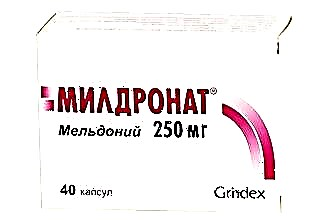Angina has several forms of manifestation. The lightest and most favorable with the flow is catarrhal. With a decrease in the immune status and the concomitant effect of unfavorable factors, a purulent form of angina develops.
The course of the disease, as well as its prognosis, depend on external and internal causes, as well as on the timeliness and adequacy of the therapy. And the development or absence of complications, the restoration of the body in the rehabilitation period and the development of relapses will depend on the correctness and compliance with the regime of the treatment period.
The etiology of the disease
 Purulent tonsillitis is a lesion of the parenchyma of the tonsils, the follicular complex of the nasopharynx. The development of a chronic anginal process in people is observed more often up to 50 years old, which is explained by involutional processes in the lymphoid tissue.
Purulent tonsillitis is a lesion of the parenchyma of the tonsils, the follicular complex of the nasopharynx. The development of a chronic anginal process in people is observed more often up to 50 years old, which is explained by involutional processes in the lymphoid tissue.
The peak of the disease falls in October-January, with a decrease in the temperature of the external environment, an increase in humidity and a decrease in the general resistance of the organism. The source of infection is sick people, less often bacteria carriers.
Important! The duration of the bacterial carriage is 10-12 days after the disappearance of the symptoms of the disease.
The causes of purulent sore throat are represented by the action on the human body of bacterial and viral microflora in the form of β-hemolytic streptococcus type A, which is recorded in 70-80% of cases of the disease, and a viral agent (adenovirus, Coxsackie A virus or rhinovirus). Less often, a pathological purulent process occurs as a result of the action of streptococcus G or C.
Incubation period
 The incubation period of purulent sore throat is the time from the ingress of the pathogen to the manifestation of the first signs of the disease. The duration of the period varies from a few hours to 2-4 months.
The incubation period of purulent sore throat is the time from the ingress of the pathogen to the manifestation of the first signs of the disease. The duration of the period varies from a few hours to 2-4 months.
The latent (latent) period depends on:
- resistance (general resistance of the body to pathogenic effects);
- local tissue immunity of the tonsils (the ability of the lymphoid complex to arrest the pathological process);
- external conditions (nutritional value, lifestyle).
Clinical statistics indicate an average latency period of 3-5 days. After the end of the incubation period, a prodromal develops - a period of pronounced clinical signs.
Contributing factors
Purulent sore throat: causes of occurrence:
 decrease in resistance to a decrease in temperature (with hypothermia of the body);
decrease in resistance to a decrease in temperature (with hypothermia of the body);- sharp seasonal variability of the external environment (changes in temperature, humidity, lifestyle, nutritional value);
- predisposition to the anginal process (lymphatic-hyperplastic pathology of the tonsils);
- inflammatory processes in the nasopharynx and oral cavity (chronic rhinitis);
- mechanical injury to the tonsils;
- the state of the autonomic and central nervous system;
- chronic fatigue;
- bad ecology.
Exogenous (external) infection routes:
- Airborne.
- Alimentary (oral - when using dishes for patients and convalescents).
- Contact.
Clinical practice indicates contact infection in most cases. The causes and source of endogenous infection are autoinfection, which is constantly localized in the form of hemolytic streptococcus in the crypts of the tonsils. She also provokes chronic purulent sore throat.
Symptoms
 Purulent tonsillitis in adults lasts no more than a week (with the exception of the chronic form), after which a period of convalescence begins. Angina is presented in two forms - lacunar and follicular.
Purulent tonsillitis in adults lasts no more than a week (with the exception of the chronic form), after which a period of convalescence begins. Angina is presented in two forms - lacunar and follicular.
Follicular inflammation (damage) of the tonsils, according to the definition of Simanovsky NP, looks like a "starry sky". This picture is typical for a purulent lesion of the tonsils.
Lacunar angina is more severe than follicular. It is registered more often in children and adolescents. In adults, it has the genesis of a chronic process. The symptoms of her lesion are similar to those of follicular tonsillitis.
The purulent process is characterized by four general signs:
- There are signs of general intoxication of the body.
- Pathological purulent-dystrophic changes in the tonsils.
- The etiological factor is bacterial and / or viral microflora.
At the onset of the disease, the following are noted:
- increased body temperature - 39-40 ° C, chills;
- severe sore throat;
- intoxication phenomena (nausea, headache, vomiting);
 severe weakness in the body;
severe weakness in the body;- muscle and joint pain.
Sometimes it is observed:
- heart pain is the result of the action of the toxins of the pathogen in bacteremia;
- dyspepsia (diarrhea);
- oliguria - a decrease in urination.
Purulent tonsillitis is expressed by local clinical changes:
- hyperemia (redness) of the tonsils and their strong swelling;
- pronounced regional lymphadenitis - inflammation of the cervical, submandibular lymph nodes;
- an increase in follicles and their inflammation with the formation of whitish-yellow formations.
Pharyngoscopic changes are characterized by the appearance of areas of yellow-white plaque, which is formed at first only limited in the lacunar orifice, and with the generalization of the inflammatory process, more and more areas of the tonsils are filled with pus.
Plaque is easily removed for 2-5 days of illness. In this case, the epithelial layer is not damaged. This period is marked by a decrease in temperature and a slight improvement in the patient's condition.
 Subfebrile temperature is observed for several more days. It normalizes after the completion of inflammatory processes in the lymph nodes. In case of diphtheria lesion, on the contrary, surface trauma is always observed.
Subfebrile temperature is observed for several more days. It normalizes after the completion of inflammatory processes in the lymph nodes. In case of diphtheria lesion, on the contrary, surface trauma is always observed.
Important! A purulent lesion never extends beyond the tonsils.
The state of the immune status determines how long a purulent sore throat lasts. With good resistance, the disease lasts 5-7 days, but with the development of complications it turns into a subacute (3-6 weeks) and chronic period (6 weeks or more).
Possible complications
Signs of regional lymphadenitis persist for 10-12 days. The period of clinical development of the disease without treatment is 5-7 days and is accompanied by the development of complications.
The secondary signs of the disease that have arisen answer the question of what are anginal consequences. They are represented by early (purulent) complications that occur on the 4th-6th day of the disease and late (non-purulent) complications.
 Early complications:
Early complications:
- paratonsillar abscess;
- cervical lymphadenitis.
- Late complications:
- post-streptococcal glomerulonephritis, toxic shock - develops on the 8-10th day during the period of convalescence;
- rheumatic fever - occurs 2-3 weeks after the relief of the anginal process.
Important! Rheumatic fever in 1/3 of manifestations is a consequence of streptococcal purulent tonsillitis.
The fever proceeds latently (the clinic is erased) - slight weakness with a satisfactory state of health, the temperature is subfebrile (or within normal limits). There is a slight sore throat, which goes away on its own after one to two days.
The sick often do not go to the doctor, but prescribe treatment on their own, without using antibacterial agents. This leads to a decrease in immunity, the formation of a stationary focus of pathogenic microflora (promoting autoinfection), subsequent recurrence and the creation of a pathogenic vicious circle - "the source of the pathogen-angina-source of the pathogen."
Local complications after purulent tonsillitis - paratonsillitis and paratonsillar abscess - are manifested:
- one-sided pain in the pharynx - increases with swallowing;
 hypersalivation (increased salivation);
hypersalivation (increased salivation);- pyretic (40-41 ° C) fever;
- trismus (convulsive contraction of the masticatory muscles), arthralgia (joint pain when opening the mouth);
- edema of the palatine arch of the affected side and hyperemia of the soft palate;
- asymmetry of the uvula towards the affected tonsil.
Chronic tonsillitis causes systemic lesions, which are expressed by metatonsillar diseases:
- myocarditis of an infectious - allergic nature;
- rheumatoid inflammation of the joints;
- polyarthritis;
- cholecystocholangitis (inflammation of the gallbladder and bile ducts);
- glomerulonephritis (purulent inflammation of the renal pelvis).
The positive is that timely treatment avoids rheumatism and polyarthritis, even when the sore throat is purulent.
Paratonsillar abscess requires urgent hospitalization and surgical treatment. If it is not taken, then the purulent process will spread to the deep fascia, cause inflammation of the tissue, deep tissues of the cervical regions and lead to the development of sepsis.
 With repeated (chronic) angina, a characteristic symptom is observed - hyperemia of the cheeks with severe pallor of the nasolabial triangle (a diagnostic sign in differential diagnosis).
With repeated (chronic) angina, a characteristic symptom is observed - hyperemia of the cheeks with severe pallor of the nasolabial triangle (a diagnostic sign in differential diagnosis).
Important! Chronic purulent tonsillitis provokes the development of myocarditis in the first days of the disease. Symptomatically, this complication does not appear. You can determine the pathology during the passage of the electrocardiogram. Glomerulonephritis occurs on the 8-10th day of illness, the only symptom of which is persistent urinary syndrome with moderate proteinuria (protein in the urine).
Treatment and prevention
At the first signs of the disease, it is necessary:
- call a doctor at home;
- adhere to bed rest and follow the recommendations of the attending physician;
- provide plenty of drinking, taking multivitamins or fortified foods.
 It is necessary to observe bed rest for the first 2-3 days of the disease. Later, if the state of health improves, you can switch to half-bed and just a home regimen, which is provided until normal body temperature stabilizes (up to 7-10 days). How much the patient has recovered will be confirmed by the results of the cardiogram and laboratory tests of blood and urine.
It is necessary to observe bed rest for the first 2-3 days of the disease. Later, if the state of health improves, you can switch to half-bed and just a home regimen, which is provided until normal body temperature stabilizes (up to 7-10 days). How much the patient has recovered will be confirmed by the results of the cardiogram and laboratory tests of blood and urine.
After improving the condition, you should not immediately start heavy physical activity. The body should be given the opportunity to grow stronger. An indicator of recovery will be a stable body temperature (up to 37 ° C) for 5 days, an improvement in general condition, a surge of strength, the appearance of appetite and vivacity.
Prevention involves strengthening the defenses, increasing the body's immune status, eliminating an unfavorable cause (hypothermia, contact with patients).
If purulent tonsillitis occurs, in order to avoid infection of family members, the patient should avoid close contact with them if possible, use a separate set of dishes and linen. It should be remembered that the carrier of bacteria in convalescents is observed for 10 -12 days after recovery.

 decrease in resistance to a decrease in temperature (with hypothermia of the body);
decrease in resistance to a decrease in temperature (with hypothermia of the body); severe weakness in the body;
severe weakness in the body; hypersalivation (increased salivation);
hypersalivation (increased salivation);

